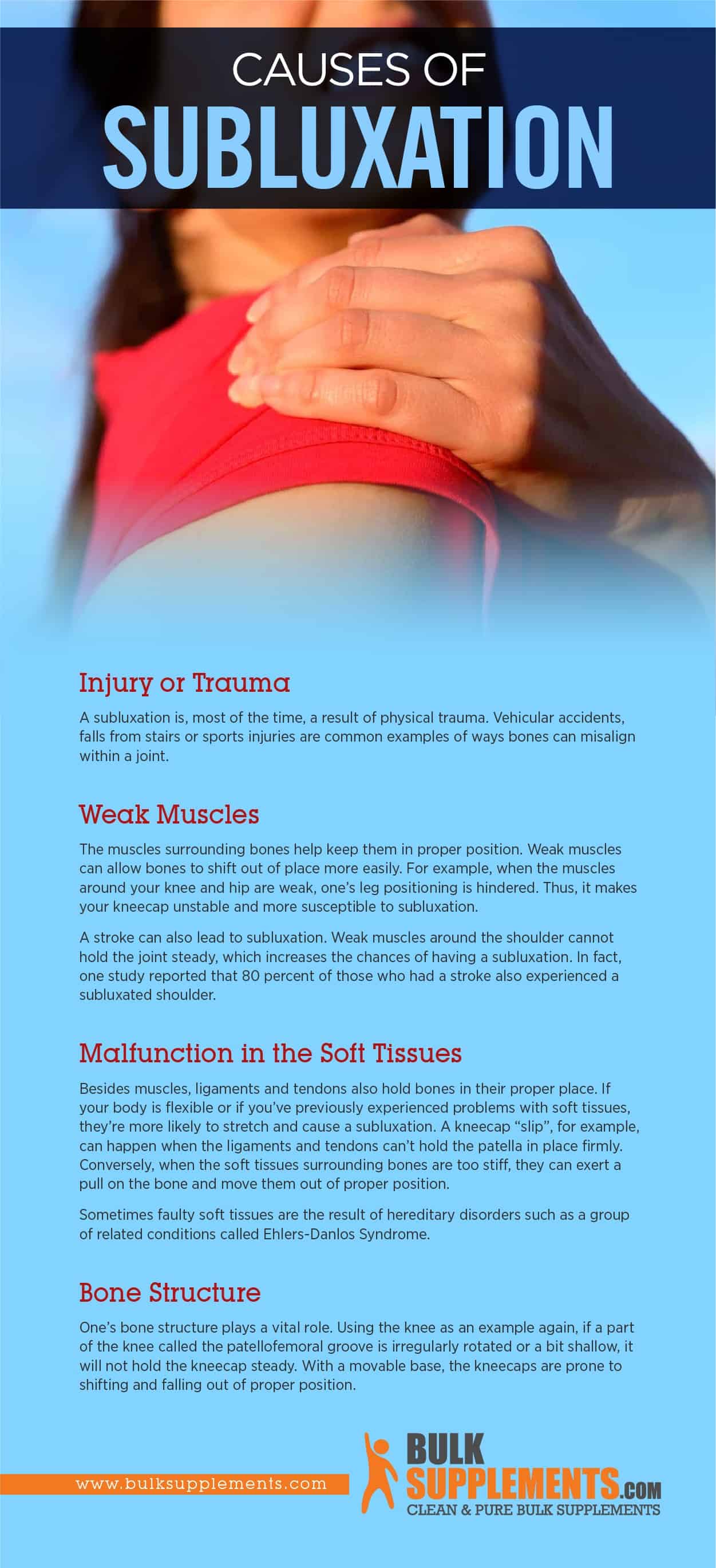Subluxation: Symptoms, Causes & Treatment
by James Denlinger Digital Marketing Strategist
What is a Subluxation?
Many people have heard of — or have even experienced — a dislocated joint. This painful occurrence is most common in synovial joints, which are the free-moving joints that allow mobility between two bones (think shoulders, knees and hips, for example.) When one bone becomes completely detached from another within a joint, it’s been dislocated. A partial detachment of two bones, however, is called a subluxation.
Certain joints like elbows, knees, shoulders, fingers, hips and jaw endure a lot of wear and tear and therefore are more susceptible to subluxation. Injuries from accidents or sports can cause it. Damage to a joint occurring within the body resulting from factors like arthritis, for example, can also lead to subluxation.
Subluxations vary in severity. Sometimes joints simply go back into place on their own while other cases require physical therapy or surgery to restore mobility and prevent further damage to the surrounding tissue. Certain dietary supplements can also be useful for reducing inflammation and pain.
Subluxation Symptoms
If not treated as soon as possible, subluxation can lead to painful bone injuries. Luckily, there are less painful signs that infer this condition. Many parts of the body can become subluxated and symptoms can differ depending on the location. Some common locations and their symptoms include:
Patella (Kneecap)
Patellar subluxation occurs when there is a partial dislocation of the kneecap from its usual position in the groove located at the end of the femur — a bone located in the thigh. Signs could be:
- Stiffness of the knee
- Pain while sitting with knees extended
- Locking of the knee
- Pain which worsens after any kind of activity
- Swelling of the knee
- Slipping of the kneecap to the outer part of the knee
- Popping or cracking of the knee
Shoulder
This subluxation happens when the ball of the humerus (the bone in the upper arm) partially protrudes from the shoulder bone’s socket, also called the glenoid socket.
- Numbness along the arm
- Difficulty moving the joints found in the shoulder area
- Weakness of the arm
- Swelling of the shoulder
- Visible deformation of the shoulders
- Bruising
Spine
Spinal subluxation develops when a spinal vertebra is misaligned compared to the other vertebrae.
- Difficulty in moving or immobility
- Persistent headaches
- Pain in the neck, especially prominent in the back
Complications
Subluxations of the bones may result in tissue damage surrounding the synovial joint. Some of the tissues that may be affected by this partial bone disunion are the joint capsule (the tissue that connects the bones and covers the joint), the articular cartilage (the cartilage that is present on top of the bones that are articulating or meeting up) and the ligaments that surround the joint itself.
Subluxation Causes
Injury or Trauma
A subluxation is, most of the time, a result of physical trauma. Vehicular accidents, falls from stairs or sports injuries are common examples of ways bones can misalign within a joint.
Weak Muscles
The muscles surrounding bones help keep them in proper position. Weak muscles can allow bones to shift out of place more easily. For example, when the muscles around your knee and hip are weak, one’s leg positioning is hindered. Thus, it makes your kneecap unstable and more susceptible to subluxation.
A stroke can also lead to subluxation. Weak muscles around the shoulder cannot hold the joint steady, which increases the chances of having a subluxation. In fact, one study reported that 80 percent of those who had a stroke also experienced a subluxated shoulder.
Malfunction in the Soft Tissues
Besides muscles, ligaments and tendons also hold bones in their proper place. If your body is flexible or if you’ve previously experienced problems with soft tissues, they’re more likely to stretch and cause a subluxation. A kneecap “slip”, for example, can happen when the ligaments and tendons can’t hold the patella in place firmly. Conversely, when the soft tissues surrounding bones are too stiff, they can exert a pull on the bone and move them out of proper position.
Sometimes faulty soft tissues are the result of hereditary disorders such as a group of related conditions called Ehlers-Danlos Syndrome.
Bone Structure
One’s bone structure plays a vital role. Using the knee as an example again, if a part of the knee called the patellofemoral groove is irregularly rotated or a bit shallow, it will not hold the kneecap steady. With a movable base, the kneecaps are prone to shifting and falling out of proper position.

Chiropractic View of Subluxation
Everything described thus far refers to a “medical subluxation”, or one that can generally be seen on an imaging test like an X-ray. To chiropractors however, whose practice is largely based on manual manipulation of the joints to restore mobility and overall health, subluxations hold a far greater significance.
The practice of many Doctors of Chiropractics (DCs) involves the notion that even extremely subtle subluxations of the spine — sometimes undetectable through imaging — cause disruptions in nerve function that undermine the body’s natural ability to maintain health. Pain, mood disorders and disease, for example, can be prevented or treated through physical manipulation, or “adjustments” of the spine.
Chiropractors assert that subluxations, even tiny, can cause a lot of health problems that would seem unrelated. Similarly, the causes of subluxations aren’t limited to just injury or structural problems within the body. A view within chiropractics holds that subluxations can be caused by other hard-to-measure factors like emotional upsets, an unhealthy diet and the accumulation of toxins in the body.
Historically, the profession of chiropractics hasn’t enjoyed the same esteem as conventional medicine. Even within the chiropractic community, debate continues over the role that “subluxation syndrome” should play in the way DCs treat their patients. Nevertheless, many people have found great relief of back pain and other ailments through chiropractic treatment.
Subluxation Treatment and Remedies
For a subluxation to heal, the displaced bone needs to put back into place. This can be relatively easy to do. For example, a professional healthcare provider could put a bone back into its socket by applying pressure. In other cases, it can be a tricky undertaking requiring a surgeon. After the bone returns to its proper position, focus of the treatment shifts to reducing swelling, discomfort and chances of reoccurrence.
Rest
Resting, while so easy, is often the hardest thing to do. It’s important to try to keep the injured area still, however, so that tissue surrounding the bone can begin to heal. Resting may include use of a sling, crutches or splint, depending on what part of the body is subluxed. Putting a limit on the pressure and force of the targeted joint may also reduce the swelling of the joints.
Ice
Applying ice on the swollen part of the body can reduce the inflammation. Using ice on inflamed joints at least 2 to 3 times per day for 20-30 minutes at a time (per your healthcare professional’s advice) can relieve pain and swelling.
Elevation
Elevating a subluxated area can help reduce swelling.
Physical Therapy
Depending on the severity, location, and other details of the subluxation, physical therapy may be indicated to restore strength and mobility in the affected area.
Glucosamine
While there aren’t any supplements that can directly prevent a subluxation from occurring, studies show that taking additional glucosamine — a substance naturally found within the joints — can help reduce pain and speed healing from joint injuries. As a dietary supplement, take 1,000 mg up to three times daily, or as directed by a physician. Women who are pregnant or nursing should first discuss supplementation with a health care professional.
Fish Oil
Omega-3 rich fish oil has been recommended for reducing the pain and inflammation associated with the autoimmune condition rheumatoid arthritis. However, studies now suggest that supplementing with fish oil can also alleviate pain and swelling in joints due to other causes. As a dietary supplement, take 1 or 2 fish oil softgels 2-3 times per day or as directed by your healthcare professional. Side effects resulting from overuse include diarrhea, acid reflux and general gastrointestinal upset. Anyone that is allergic to fish or taking blood thinners should avoid this product or talk to a doctor before use.
The Bottom Line
While it may not be life-threatening, subluxation can cause permanent damage if it goes untreated or becomes complicated. The most common cause of subluxation is traumatic force, i.e., accidents or sports injuries. However, some people are more prone to recurrent subluxations due to factors like unusually flexible connective tissue, their bone structure, genetic predisposition, or prior injuries. Seeking prompt medical attention to put the bone back into place, as well as taking measures that allow it to heal properly minimize the risk of permanent nerve damage and loss of mobility. Rest, ice, physical therapy, and even surgery may all be necessary.
Sponsor Ads
Created on Feb 27th 2020 15:37. Viewed 322 times.



